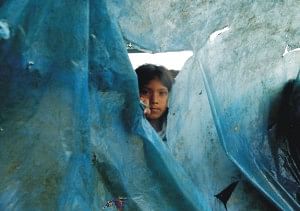Human Rights advocacy
Sexual
abuse and our Children: Time to speak out
Sultana
Razia
Home,
which we believe to be the safest place for our children,
is also the most convenient place for the perpetrators
of child sexual abuse. Child sexual abuse includes a wide
range of sexual behaviours that take place between a child
and an older person. It is not well defined in our legal
system. There are many forms of sexual abuse not synonymous
with rape. It has different forms and names.
From
the experience of some case studies of Breaking the Silence--
a non governmental organisation, which has been working
in this issue for the last 11 years, has identified many
forms of sexual abuse that people in general are not familiar
with. Any discussion on this subject is usually considered
as a taboo.
Who
are the perpetrators of child sexual abuse?
The term, 'child sexual abuse' is not defined in our domestic
laws. According to Julia Whealin, from the National Center
for Post Traumatic Stress Disorder, legal definitions
of what constitutes child sexual abuse usually require
that the perpetrator be older than the victim. For example,
in some states perpetrators must be at least five years
older than their victims for the behaviour to be considered
child sexual abuse.
From
a survey conducted by NCPST, about 60% of perpetrators
are non relative acquaintances, such as a friend of the
family, babysitter, or neighbour. About 30% of those who
sexually abuse children are relatives of the child, such
as fathers, uncles, or cousins. Strangers are perpetrators
in about 10% of child sexual abuse cases. However, women
are found to be perpetrators in about 14% of cases reported
against boys and about 6% of cases reported against girls.

photo:AFP |
Children:
most vulnerable victims
A victim is someone who suffers directly or threatened
physically and emotionally as a result of the commission
of a crime. A person can also be a victim though s/he
has not suffered directly.
In
Sakshi vs. Union of India and Ors., Writ Petition (Crl.)
No. 33 of 1997 case the Supreme Court observed that the
laws relating to rape are not adequate to cover various
sexual atrocities against woman or children.
Normally
children, who are abused do not have enough strength to
protect themselves and most of the time they remain silent
about the incidents of sexual abuse. That only encourages
such crimes.
Laws
regarding sexual abuse
According to article 34 of the Convention on the rights
of the Child, "States Parties undertake to protect
the child from all forms of sexual exploitation and sexual
abuse. For these purposes, States Parties shall in particular
take all appropriate national, bilateral and multilateral
measures to prevent:
(a)
The inducement or coercion of a child to engage in any
unlawful sexual activity;
(b)
The exploitative use of children in prostitution or other
unlawful sexual practices;
(c)
The exploitative use of children in pornographic performances
and materials. "
Section
10 of Repression against Women and Children Act 2000 states
that, if a man in order to satisfy his unlawful sexual
desire touch a sexual organ or any other part of the body
of a women /child with his organ or by any other object,
it will be considered as sexual harassment. This section
indicates two things, namely, "touching of a female
organ" and "improper attitude" although
"improper attitude" has not been defined.
In
some extent, physical abuse is defined but there in nothing
about psychological abuse. This act provides rigorous
imprisonment of not more than ten years and not less than
three years with fine for sexual harassment. It also state
that, if anyone outrage the modesty of women or make obscene
gestures, will be sentenced to rigorous imprisonment for
not more than seven years and not less than two years
with fine.
Some
myths about child sexual abuse
There are some myths regarding child sexual abuse, like:
Child
sexual abuse only occurs in poor families. From a data
of Breaking the Silence, out of 26 cases, there was one
victim from a rich family, 13 abused children were from
middle class families, three from lower middle class and
nine from poor economic background.
Child sexual abuse produces physical injury; Many forms
of child sexual abuse do not involve force. Such as, fondling
which child recognises as being of a different type from
usual. But its effect is long lasting. Sometimes traumatised
children lose their interest in life and may even try
to commit suicide.
Perpetrators of child sexual abuse are either mentally
ill or subnormal; It is very difficult to recognise such
perpetrators. Most of the time they are looking for opportunities.
Children appearing bright and attractive are subject to
sexual abuse; even babies in arms and toddlers are also
suffering from abuse.
Counselling
a way out
For the abused children, support from their own family
is a must. In our country, a few non-governmental organisations
and some psychologists provide expert counselling for
the victims and their parents.
We
should remember that the abused children are our children
and we must take action against child sexual abuse immediately
and punish the perpetrators. Enforcement of our current
laws are required and sexual abuse should properly be
defined at first.
-From
Law Desk.